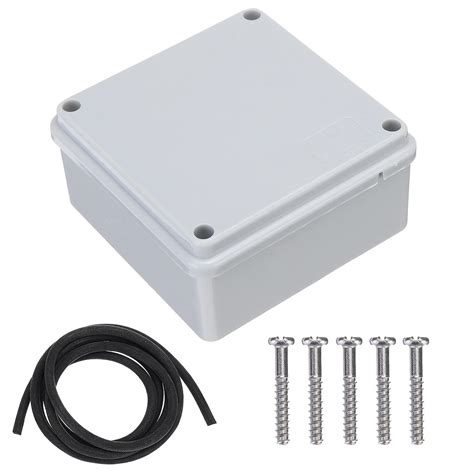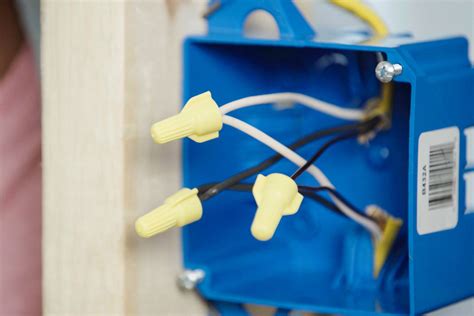covering junction box You are correct, the junction boxes must remain accessible. The NEC 314.29 . Sheet metal stamping is the process of transforming sheets of metal material into a useful component or part. During the process, metal is fed into a press where a stamping tool, referred to as a die, presses through or into the metal with great force to create the desired shape.
0 · weatherproof junction box cover
1 · junction cover for electrical box
2 · junction box transparent cover
3 · electrical junction box cover plate
4 · decorative junction box cover plate
5 · decorative junction box cover
6 · decorative electrical junction box covers
7 · 4x4 junction box with cover
ROUND BOX for ceiling light fixtures, smoke alarms, carbon monoxide detectors and wall sconce light fixtures. 22-CU.-IN. SINGLE-GANG BOX for a typical outlet or switch.
You cannot cover any junction box that still has live wires in it. Your best bet is to either remove the box all together or just put a cover plate on it.The junction boxes that contain splices and are not accessible from the ceiling below .
You are correct, the junction boxes must remain accessible. The NEC 314.29 . The IRC and NEC don’t expressly prohibit covering a junction box with insulation. However, they require junction boxes to be readily accessible without removing a permanent finish. In some cases, insulation might classify .
A: No, a junction box should not be completely covered by insulation. The junction box should remain accessible, which means it should . We know that the covers for electrical boxes need to be accessible, but what if the box is located in an attic? Is it acceptable to bury the box in insulation? I said I’d research this info and get back to him, but I thought this .
The junction boxes that contain splices and are not accessible from the ceiling below should be exposed - not covered by insulation. If enough slack is present in the cables . Answer: Paragraph (b)(3) of §1926.405 applies only to pull and junction boxes installed on systems of more than 600 volts. If none of the conductors within the box were over .
Learn installation rules, NEMA categorizations, and crucial FAQs for a secure wiring setup. What Is A Junction Box? A junction box is an electrical enclosure that houses one or more wiring connections.
You are correct, the junction boxes must remain accessible. The NEC 314.29 prohibits covering up boxes such that you'd need to remove "part of the building" to access the . A junction box covered by a plastic cover is considered identifiable and accessible. A junction box (or worse, a splice hanging in the wall) covered by drywall is not identifiable or .You cannot cover any junction box that still has live wires in it. Your best bet is to either remove the box all together or just put a cover plate on it. Junction boxes must be securely supported to prevent them from coming loose or moving. In addition, they have to be supported by framing, clamps or other similar supports. Box covers must be securely fastened to prevent accidental contact with live conductors.
The IRC and NEC don’t expressly prohibit covering a junction box with insulation. However, they require junction boxes to be readily accessible without removing a permanent finish. In some cases, insulation might classify as such. Consulting a .

stanley 26 galvanized metal tool box
weatherproof junction box cover

A: No, a junction box should not be completely covered by insulation. The junction box should remain accessible, which means it should not be closed in or blocked by insulation. Completely covering a junction box with insulation can create potential safety hazards and make it difficult to access the electrical connections inside if needed. We know that the covers for electrical boxes need to be accessible, but what if the box is located in an attic? Is it acceptable to bury the box in insulation? I said I’d research this info and get back to him, but I thought this might make for a good, short blog post topic.
The junction boxes that contain splices and are not accessible from the ceiling below should be exposed - not covered by insulation. If enough slack is present in the cables between the boxes, you may be able to raise them up a bit and mount them on trusses or other exposed framing members without having to run new wire. Answer: Paragraph (b)(3) of §1926.405 applies only to pull and junction boxes installed on systems of more than 600 volts. If none of the conductors within the box were over 600 volts, then the requirement in question does not apply.Learn installation rules, NEMA categorizations, and crucial FAQs for a secure wiring setup. What Is A Junction Box? A junction box is an electrical enclosure that houses one or more wiring connections.
You are correct, the junction boxes must remain accessible. The NEC 314.29 prohibits covering up boxes such that you'd need to remove "part of the building" to access the wires inside. The drywall is considered "part of the building."
A junction box covered by a plastic cover is considered identifiable and accessible. A junction box (or worse, a splice hanging in the wall) covered by drywall is not identifiable or accessible. You should never bury a live wire, period.You cannot cover any junction box that still has live wires in it. Your best bet is to either remove the box all together or just put a cover plate on it. Junction boxes must be securely supported to prevent them from coming loose or moving. In addition, they have to be supported by framing, clamps or other similar supports. Box covers must be securely fastened to prevent accidental contact with live conductors.
The IRC and NEC don’t expressly prohibit covering a junction box with insulation. However, they require junction boxes to be readily accessible without removing a permanent finish. In some cases, insulation might classify as such. Consulting a . A: No, a junction box should not be completely covered by insulation. The junction box should remain accessible, which means it should not be closed in or blocked by insulation. Completely covering a junction box with insulation can create potential safety hazards and make it difficult to access the electrical connections inside if needed.
We know that the covers for electrical boxes need to be accessible, but what if the box is located in an attic? Is it acceptable to bury the box in insulation? I said I’d research this info and get back to him, but I thought this might make for a good, short blog post topic.
The junction boxes that contain splices and are not accessible from the ceiling below should be exposed - not covered by insulation. If enough slack is present in the cables between the boxes, you may be able to raise them up a bit and mount them on trusses or other exposed framing members without having to run new wire. Answer: Paragraph (b)(3) of §1926.405 applies only to pull and junction boxes installed on systems of more than 600 volts. If none of the conductors within the box were over 600 volts, then the requirement in question does not apply.
junction cover for electrical box
Learn installation rules, NEMA categorizations, and crucial FAQs for a secure wiring setup. What Is A Junction Box? A junction box is an electrical enclosure that houses one or more wiring connections. You are correct, the junction boxes must remain accessible. The NEC 314.29 prohibits covering up boxes such that you'd need to remove "part of the building" to access the wires inside. The drywall is considered "part of the building."
stanley metal lunch box

The K-factor is the ratio of the location of the neutral axis to the material thickness for sheet metal. The neutral axis divides the cross-section into two regions — compressive and tension. Its position shifts when the sheet .
covering junction box|decorative junction box cover